Why do students think they have to choose to be “good at math” or “good at English”? Why do they assume the two are somehow disconnected?
The fact is that math can enhance students’ abilities in written and oral communication skills, and language arts can increase their ability to communicate their understanding for a content-specific reason. Our students need to experience that connection.
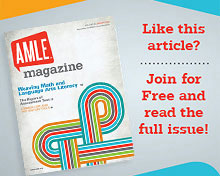
The Algebra Project (AP), founded by civil rights leader Robert Moses in the late 1980s, helps students see language as a way to access mathematics. The AP has worked for decades creating strategies (how to teach) and materials (what to teach) that increase students’ demand for challenging college-preparatory mathematics. In concert with its sister organization, the Young People’s Project (YPP), the AP incorporates students’ peer culture inside and outside the classroom to increase student interest in challenging math.
The AP is based on a five-step process. The implementation of the process, which is simplistic in form, requires math teachers to step out of their typical structured lesson and into the world of the students’ own language and understanding. It allows students to be the creators and thus inventors of their own mathematical understanding through connections the teacher helps illuminate.
The process bridges prior knowledge of events, experiences, and understanding with the world of mathematical language and sense-making. It also reaches the English/language arts foundational areas of informative and explanatory texts, range of writing, and text types and purposes.
The AP Five-Step Process
The steps of the AP process are defined here, each with a note about the purpose and complexities within. Math teachers can implement the steps in their own way; however, the structure and order should be consistent.
Step 1. The Shared Experience. The five-step curricular process begins with a shared experience, which is an activity, task, or game that is open-ended and can be a stand-alone experience or one built on students’ life experiences. The teacher should provide an experience that is accessible to varied levels of student understanding and allows for multiple representations of mathematical ideas.
A teacher who is just beginning to use the five-step process might select a game or activity from the student text or find an activity from a math methods text that allows for multiple entry points. For example, the students may work together to create rectangular prisms out of 12 cubes.
Step 2. The Picture or Model of the Experience. In the second step, students draw a picture that reflects the shared experience. For example, after creating rectangular prisms out of 12 cubes, they might draw a 3-D representation of the rectangular prism.
When they are new to the process, students sometimes draw items outside the actual mathematics of the experience. For instance, using the prism example, rather than drawing a 3-D representation of the rectangular prism, some students may draw themselves and others building the prism. As the students continue to use the process, and as teachers highlight student work samples to the class, the drawings become more and more mathematical in their representation.
Step 3. The People Talk. There are two general possibilities for Step 3. First, students may work together in small groups to write a story about their experience—such as building the prism. This collaborative writing experience allows students to share their mathematical experience in their own language, which becomes a stepping off place for a large-group discussion. An alternative is to have each student write his or her own “story” about the experience.
A good prompt from the teacher is “Explain what you did during the shared experience as if you were trying to tell someone who wasn’t here what happened.”
When students first engage in this process, they often respond with a list of directions instead of truly explaining their thought process. This changes over time as students become familiar with the process and as teachers share student work that demonstrates the type of descriptive writing they are looking for.
The teacher can share the students’ representations with the larger class group in two ways. First, the teacher might ask a group to select a picture and a piece of writing that they think are a good representation of the group’s thoughts as a whole. Or, the teacher might roam the classroom and make purposeful selections of a variety of examples of students’ drawings and writings.
Step 4. The Feature Talk. In this fourth step, the teacher helps students bridge their language and pictorial representations of the mathematical concepts. They work together to “mathematize”
the People Talk through discussion. The teacher uses questions such as, “What are some of the common themes that occurred in our classmates’ writing or pictures?” Or, “If we were to think about this experience as a recipe, what ingredients would we need?”
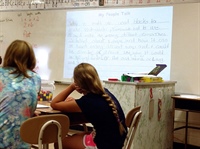
The Feature Talk step helps students share their observations and make connections.
For teachers, the most difficult aspect of this stage is the need to use restraint. Teachers must help students find a way to connect their own written terms to the mathematical ideas without forcing the teacher’s ideas. In a traditional classroom, the teacher “tells” students the connections instead of setting up the students, through questioning, to find their own sense-making which is connected to their own language.
Step 5. The Symbolic Representation. There is a language of mathematics. Teachers use a mathematic symbol or term and describe what it is. However, it’s more organic for the students to show the mathematical concept they learned by using invented or traditional symbols to represent their thinking. When students convey the mathematical understanding to others, their symbols may be different, but that leads to the realization that a common symbol is necessary for communicating mathematically. It is enlightening for students to invent their own symbol for short-term use, followed by a generalized symbol that connects to the one they invented.
This step is difficult for teachers, as it is the reverse of the way we usually teach. But remember that students need that real connection in order to internalize the concept.
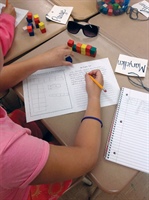
Students show mathematical concepts by using invented or traditional symbols to represent their thinking.
For example, a student might use a symbolic representation as demonstrated in the photo below, which leads to the more structured symbolic representation of: 2 x 1 x 6. Once that symbol is made clear, for the next few days the teacher might have students experiment with other applications of that symbolic representation; for example, showing the students another rectangular prism and asking what the symbolic representation might be for the new figure. Or, the teacher could write a symbolic representation for another rectangular figure and ask the students to create that rectangular prism.
Connections to This We Believe
The easiest way to describe how the application of the five-step process fits middle level curriculum best practices is to break it down based on the Association for Middle Level Education’s (formerly National Middle School Association) essential attributes from This We Believe.
1. Developmentally Responsive: The five-step process capitalizes on “using the nature of young adolescents as the foundation on which all decisions are made.” Typically, we see this happening in the context of classroom environment or student participation in a school’s structures or leadership. But, this is also directly related to student-reactive pedagogy.
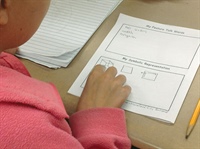
Students expand on their knowledge to create a more structured symbolic representation.
The nature of the students’ representation and words is a structure through which all students contribute to the direction of the mathematical thinking, communications, and discovery of connecting their world to the constructs of mathematics. The students own the path along which they travel to a personal understanding of the concept.
2. Challenging: The recognition that “every student can learn and everyone is held to high expectations” is highlighted in the pre-lesson decision-making process of the teacher, who must consider, “What experience can we engage in that has multiple entry points to allow for a varied zone of proximal development that can be accessed by all students? How can students be engaged and own decisions in a way that connects with personal experiences, language, and complexity of understanding?” There is no correct path, just a path that makes sense for each student.
3. Empowering: Through the five-step process, students begin with an experience that they make their own. They continue owning the process through the second and third steps. When the class engages in the Feature Talk, they lead the discussion through their realities, their words, and their understandings.
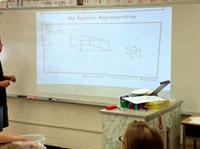
When students convey mathematical understanding to others, they realize the importance of common symbols.
It is the teacher’s role to facilitate discussion around the analysis and synthesis of student work and to determine how to ask questions about similarities and clusters of ideas brought to the table by all and to connect that to the mathematical structures of the concept. All students—not just the “ones who are good at math”—are math players, not simply observers.
4. Equitable: This We Believe calls for “advocating for every student’s right to learn and providing challenging and relevant learning opportunities.” How often in a mathematics classroom do we see the same students raise their hands and dominate the environment of that classroom?
The five-step process works beautifully to provide equitable access to exploration, verbalization (written and oral), and connection. All students’ ideas are shared and hold equal weight. It is the responsibility of the teacher to look for the gems of insight that lead to the understanding of the concept. These gems come from the multiplicity of representation of student understanding. All students not only have a stake in what will be discovered, but also a voice in how it will be discovered.
Seamless Integration
Using the five-step process in a middle level classroom seamlessly integrates writing, reading, and mathematics. It demonstrates that skill and effort in all three areas are needed for true mathematical sense making and understanding. It is more than interdisciplinary—it is transdisciplinary.
Terri Teal Bucci is an associate professor of mathematics education and co-director of the Math Literacy Initiative at the Ohio State University at Mansfield. bucci.5@osu.edu
Lee J. McEwan is a professor of mathematics and co-director of the Math Literacy Initiative at the Ohio State University at Mansfield. mcewan.1@osu.edu
Published in AMLE Magazine, January 2015.

I think this article is awesome! More math teachers should be aware of the Algebra Projects’ five-step process. Some of the steps teachers may already be utilizing but having all five present in one classroom would be very beneficial to students. As stated, the process will help students feel empowered since they are a part of their own learning, particularly in steps 3 &4.
This article was really impactful! I feel as a future math teacher that there is so much useful information in this article. The five-step process that the article describes is useful to know, just like Morgan said above, teachers may already be using one or more of these steps in their classrooms, but being able to use all five would be really rewarding. The part of the article that I enjoyed the most was how it related to This We Believe through being Developmentally responsive, challenging, and empowering. This section was so nice to read as a future and how this process relates back to the principles of the middle school.
This article was really impactful! I feel as a future math teacher that there is so much useful information in this article. The five-step process that the article describes is useful to know, just like Morgan said above, teachers may already be using one or more of these steps in their classrooms, but being able to use all five would be really rewarding. The part of the article that I enjoyed the most was how it related to This We Believe through being Developmentally responsive, challenging, and empowering. This section was so nice to read as a future educator and how this process relates back to the principles of the middle school.
I found this article very helpful. The five-step process is good information to know and be aware of. There is a possibility that teachers are already using these steps in their classroom everyday and don’t even know it.
I really enjoyed this article, especially the opening line about either being a math or English person. The five steps are very important and should be used in the classroom. Many already use some of the steps, but it would be nice if we as math teachers could include all 5 steps.
Part of me still has the mindset that “I am a math person, not an English person.” and this article touched on this topic really nicely. To me, Math and English are still disconnected but slowly they are becoming more connected as I see just how much reading and writing is within math without me realizing it. I want my future students to understand there is intersectionality between math and reading that they can use to help them improve in both content areas simultaneously.
I enjoyed reading the 5 steps provided in this article, and I liked the reference to The Successful Middle School: This We Believe. Great article.
As a future math teacher, this article is super helpful in developing meaning in not only mathematics but also Language arts. It is important to develop students sense of math identity and language identity. The importance of open ended tasks will help educators use the five AP steps appropriately.
As a pre-service math teacher, this article is super helpful in exploring how to develop students not only as mathematicians but also readers and writers. The 5-step program is super helpful, and I will be implementing it in my own future classroom!
One of the classroom strategies I thought to be helpful was step 3 the people talk. I like how students were given a math problem and their task was to write down each step they would take to get to the answer. This is really helpful for engaging instruction and for students to dig into a deeper, detailed thinking.